Solana in 2023: A Comprehensive Analysis of Developers, Network Performance, Ecosystem, and Community

In 2023, Solana faced a dynamic landscape marked by contrasting trends in developer interest, network performance, and ecosystem growth. This comprehensive analysis delves into Solana's 2023 journey, exploring the intricacies of its developer landscape, network robustness, ecosystem dynamics, and the enduring strength of its community. Let’s dive in.
Executive Summary
- Network performance: Solana's network performance has seen remarkable improvements, with uptime enhanced following 14 outages in 2022. Notably, daily transactions have surged to over 21 million (both voting and non-voting), marking a 6.2% year-over-year increase, and Solana maintains its position as one of the fastest blockchains, consistently processing over 2,000 transactions per second, outpacing competitors by orders of magnitude. The network's decentralization efforts, reflected in a Nakamoto Coefficient of 31 (largest of any L1 blockchain), coupled with strategic upgrades, showcase Solana's commitment to scalability and high-performance blockchain operations.
- Ecosystem: Solana's ecosystem, marked by a decline in daily active users from 413,000 to 193,000, rebounded with a remarkable surge to 443,000 during the week of November 20, 2023, coinciding with the Breakpoint 2023 conference. Trading volumes, holding steady at 1.5 million SOL daily, experienced a notable uptick at the end of October and November, reaching a peak of 8.2 million SOL, indicating user interest post-Breakpoint 2023. Solana's Total Value Locked (TVL) surged by 84%, growing from $367 million to $676 million between late October and November 27, 2023, underlining increased confidence in the ecosystem. Some of the strongest new entrants into the space are the decentralized exchange Phoenix by Ellipsis Labs, lending products offered by MarginFi, Kamino Finance, and Drift, and NFT marketplace Tensor. Despite challenges, the ecosystem demonstrated resilience and improvement, with key metrics reflecting sustained growth and adaptability.
- Community: The Solana community remains vibrant, with over 3,000 attendees at the Breakpoint conference in 2023. Solana’s online hackatons were a success with over 17,000 participants across the main two. The introduction of PlayGG, a gaming-focused conference, highlights the diverse interests within the community. The OPOS narrative, emphasizing activities exclusive to Solana, resonates strongly, showcased through various projects during Breakpoint. Points programs by DeFi 2.0 protocols contribute to increased awareness, attracting new participants and generating a compounding wave of traction within the ecosystem.
- Developers: In 2023, Solana experienced significant decline in developer interest. It has suffered the second-largest decline in total developers among leading L1 blockchains, plummeting from 2,200 to 946 (-57%), and a -59% drop in commits, primarily driven by the aftermath of the FTX collapse. It maintained stability in weekly NPM library downloads with a slight decrease from 345k in November 2022 to 333k in November 2023.
Network Performance
To start off, we should analyze the network’s performance - uptime, speed, decentralization, and search for key developments, if any, to understand the network.
Uptime
Widely recognized, Solana faced performance challenges and interruptions throughout 2022 (a total of 14 outages). Following multiple updates in late 2022 and early 2023, especially after a major outage in February, the network successfully restored stability, operating seamlessly for the rest of the year. The most recent disruption occurred during the network upgrade to version 1.14 of the Mainnet beta. In response, Solana introduced a new upgrade handling plan, involving thorough stress-testing on testnets before deployment. Notably, the network also formed an adversarial team and enhanced the restart process. In addition to the new upgrade handling plan, the implementation of QUIC TPU (1), Stake weighted QoS (2), and localized fee markets (3) to better handle high traffic and demand has shown to be effective. Since these network upgrades, the network has performed without a glitch, even in periods of high stress (such as the MadLads NFT mint).




Source: https://status.solana.com/uptime?page=1
Speed
Solana continues to be one of the fastest blockchains, even across L2s, regularly achieving over 2,000 TPS (excluding vote transactions) with other major chains lagging in orders of magnitude. Closest EVM-based competitor, Polygon, processes around 179 TPS and L2s such as Arbitrum or Optimism process 13 TPS and 4 TPS, respectively. Ethereum processes around 12 TPS.
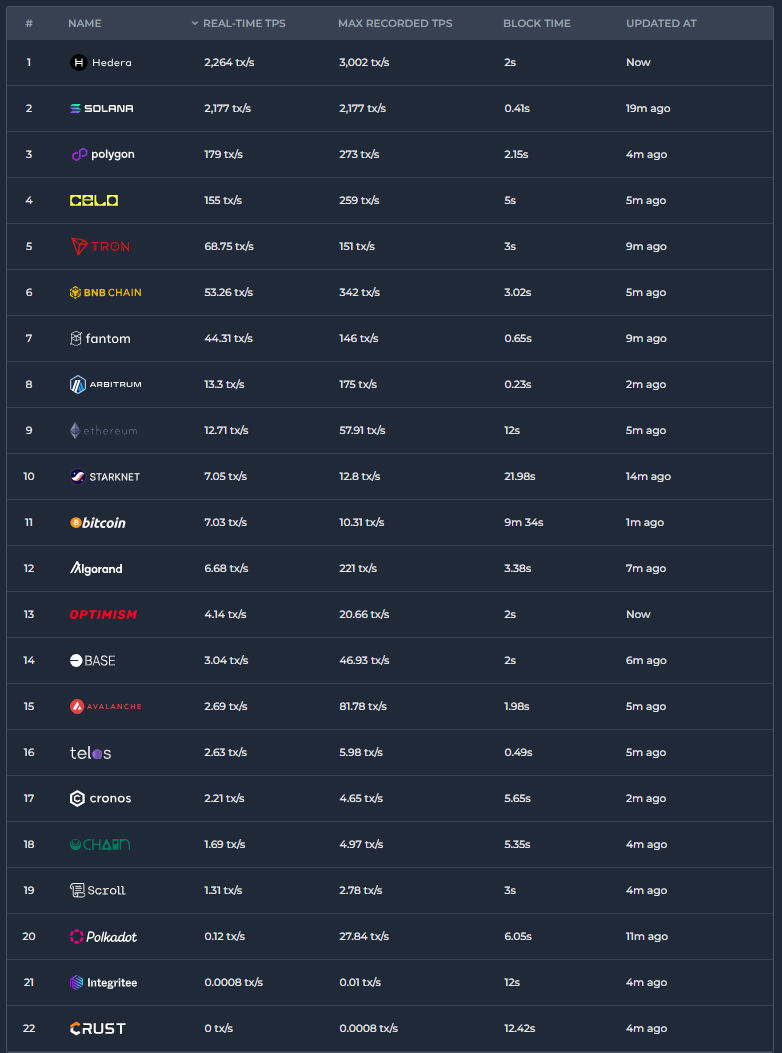
Source: https://chainspect.app/dashboard/tps
Decentralization
The Solana validator network has shown positive growth and resilience in various metrics, including node count, Nakamoto Coefficient, and node distribution. Notably, the network is on its path to become a multi-client system, with over 31% of stake running through the Jito Labs client.
 Source: https://solana.com/news/validator-health-report-october-2023
Source: https://solana.com/news/validator-health-report-october-2023
The focus on core client development emphasizes the importance of multiple validator clients for network resilience. Currently, two validator client implementations are live and two implementations are in active development.
 Source: https://solana.com/news/validator-health-report-october-2023
Source: https://solana.com/news/validator-health-report-october-2023
Solana's Nakamoto Coefficient (”NC”) remains robust at 31, signifying a decentralized network (note that Ethereum’s NC stands at 25 and Avalanches at 27). Stake distribution across data center providers and geographical regions demonstrates efforts to minimize risks and enhance resilience. The Foundation has publicly acknowledged the need for quality validators and plans to introduce initiatives to encourage node quality.
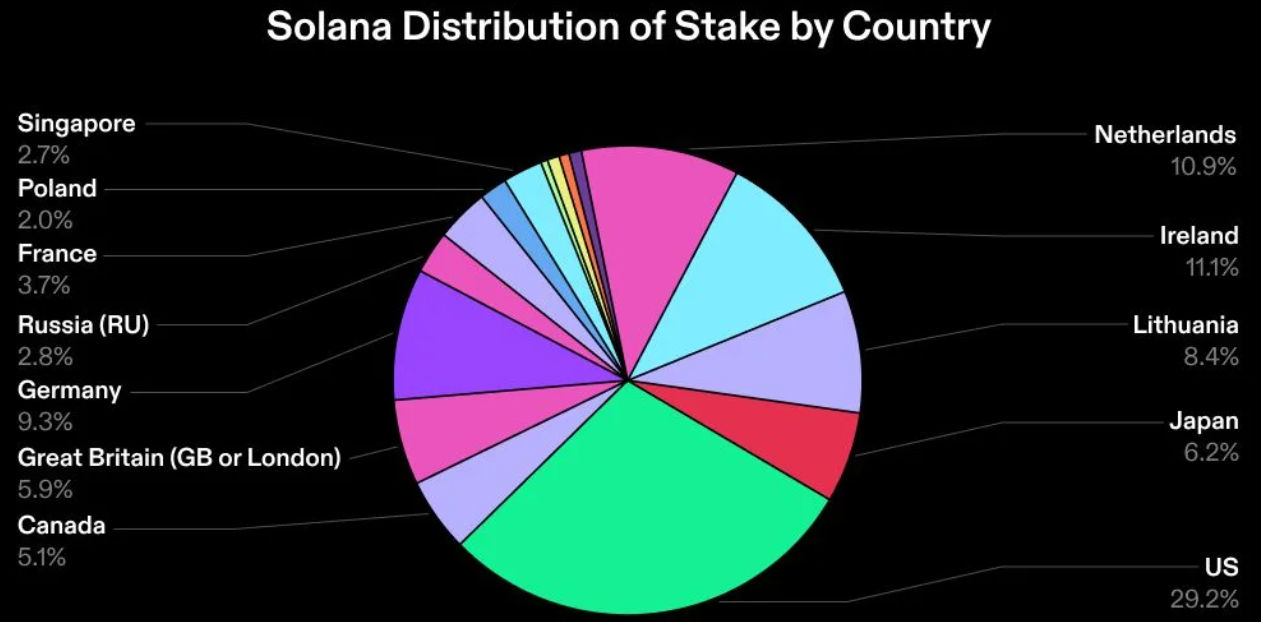
Source: https://solana.com/news/validator-health-report-october-2023
Daily transactions
Solana is consistently processing the largest number of transactions per day among any blockchain, proving the robustness of the system and quality of the underlying code.

Source: Artemis
The chain currently processes over 21 million transactions (including voting transactions) per day, up 6.2% from a year ago (19.8 million), almost 3x the number of the second largest chain (by number of transactions) Polygon, which processes around 7.8 millions daily.

Source: Artemis
Recent developments
Since its announcement on Breakpoint 2022, Jump Crypto has been working on developing Firedancer, a new, high-performant Solana validator client. Firedancer did a recent demo of high performance QUIC implementation, which should lead to more efficient data transactions and announced the launch of its testnet phase during Breakpoint 2023. If successful, Firedancer could allow Solana to reach over 1 million TPS.
Another piece of software in the cooks is Tinydancer, the first light client on Solana. Light clients are software clients that can run locally on simple devices like laptops, connecting to full nodes in the network to verify the state of the ledger and check for invalid state transitions, leading to higher verifiable decentralization of the network.
Solana’s developer tooling company - Metaplex - in cooperation with Solana Labs also introduced state compression to Solana’s stack in 2023 - a new way to store data directly on-chain that cuts down on cost by orders of magnitude. A good comparison, which showcases the power of compressed NFTs (cNFTs) was released by Solana in their blog from April 6, 2023 showcasing some of the initial use cases including DePin projects like Helium or NFT distributor Drip.Haus.
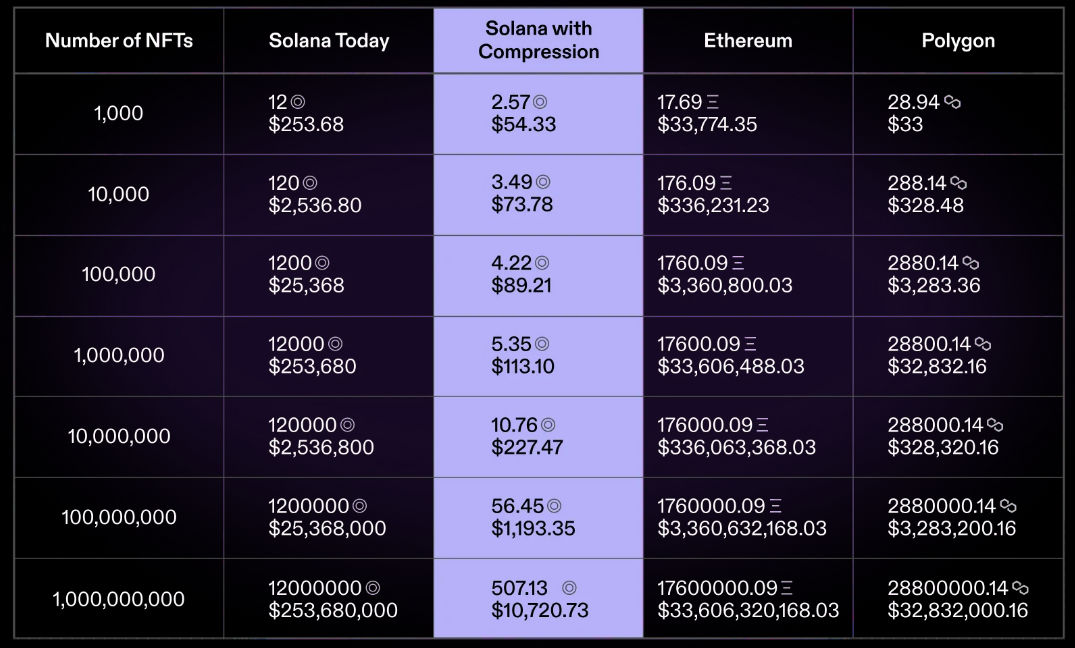
Note: At the time of the blogpost, SOL price was $21.14, MATIC at $1.14, and ETH at $1,909.45.
Source: https://solana.com/news/state-compression-compressed-nfts-solana
Throughout the year, Solana Labs also introduced Token-2022 standard, an extension to the SPL token program. This release enhances the SPL standard, offering increased functionality and flexibility for designing new tokens without sacrificing safety. Notably, Token-2022 introduces confidential transfers, enabling privacy at the network's base layer.
Solana’s adoption is becoming more evident even from the “TradFi” perspective. During Breakpoint, AWS representative announced that Solana nodes are now available for quick deployment on AWS. Similarly, Google Cloud announced the addition of Solana data on Google Cloud’s BigQuery. The integration will enable developers to query detailed Solana data.
Ecosystem
From previous sections, it appears the network is robust and has been performing exceptionally well throughout 2023 with some major developments in the works. While this might suggest that any fluctuations in developer numbers are likely transient, it is essential to underscore that the sustained vitality of a blockchain is contingent upon the flourishing ecosystem it supports. In the following analysis, let's delve into the current state of the Solana ecosystem.
Ecosystem Map
The ecosystem has been flourishing in 2023. Despite some protocols scaling down or adapting post-FTX, the Solana ecosystem remains vibrant and diverse, as illustrated in the accompanying ecosystem map. Developers are actively engaged in various user interest areas, showcasing the chain’s versatility.

Source: RockawayX
A closer look at the stack reveals that DeFi continues to be a thriving domain, marked by intense competition among spot exchanges. Orca, an AMM model-based exchange, maintains its dominance with approximately 50% market share. More recently, Solana DeFi 2.0 protocols such as the Phoenix exchange by Ellipsis Labs are entering the space, beginning to disrupt the existing order by introducing order-book-based models and quickly capturing market share (Phoenix grew market share to 10% since March 2023).

Source:https://dune.com/ilemi/solana-dex-metrics
While the trajectory of fully on-chain order-book models dominating Solana exchanges remains uncertain, some temporary impediments may slow their progress:
- Lack of market making vaults on Solana that could allow passive LPing on orderbook-style exchanges;
- Lack of active market makers in the Solana ecosystem, which generally prefer orderbook-style exchanges; and
- Potentially the use of fully on-chain infrastructure, which cannot achieve HFT (at 400ms blocktime) as opposed to the EVM-model, which often uses off-chain matching and only on-chain settlement.
Nevertheless, Phoenix's aggressive growth underscores the prevailing belief in the superiority of order books for trading, posing a credible threat to established norms.
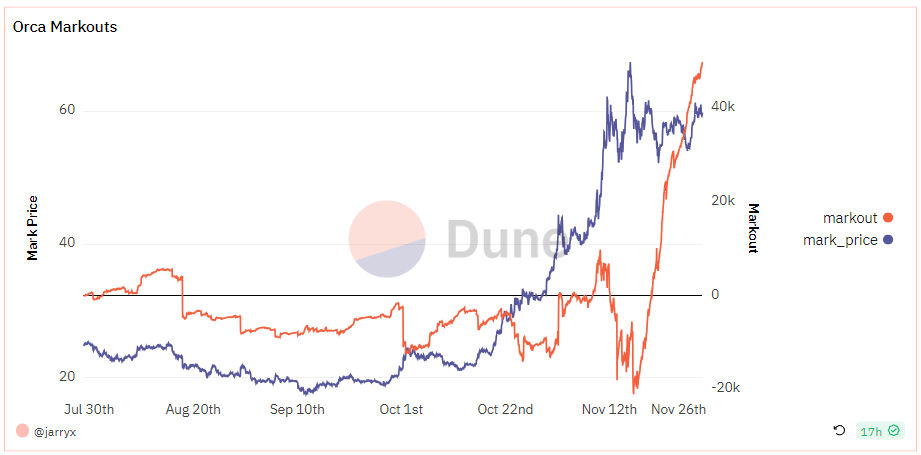
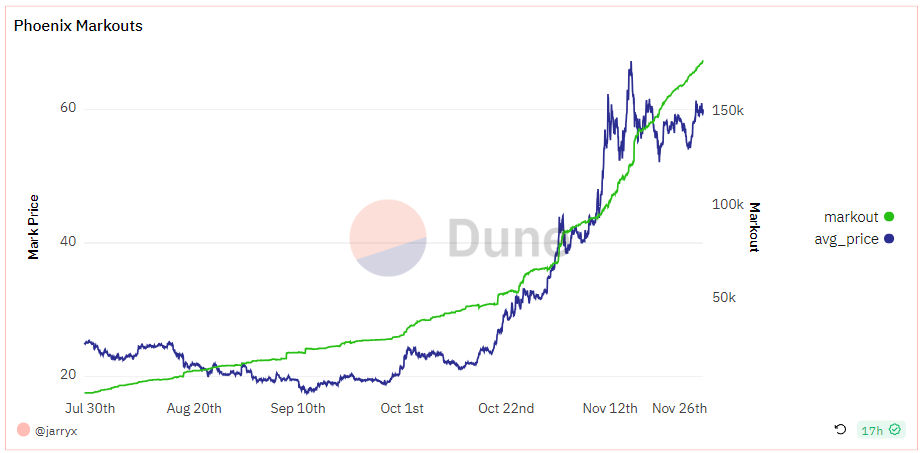
Note: The dashboard tracks the performance of liquidity providers on Solana DEXes, focusing on markouts 4 for the SOL/USDC pair. Negative markouts for Orca imply negative PnL for LPs, while Phoenix traders consistently show positive markouts.
Source: https://dune.com/jarryx/solana-defi-markouts
Lending markets are another active area of development among Solana projects. After the Mango exploit and Solend’s reputation damage caused by the governance vote enabling seizure of a whale’s account to prevent havoc in case of liquidation, new lending protocols emerged. Kamino Finance, MarginFi, and Drift emerge as strong contenders, each bringing unique strengths and features to compete for dominance.
MarginFi with its $142m in TVL definitely benefits from its live points program at the moment, but Kamino’s visionary team and a long-standing Solana protocol predominantly known for their automated yield optimization platform and Drift’s order-book-based perpetual exchange on which Drift’s lending deposits can be used as a trading margin pose a strong competition.
 Note: MarginFi Lending launched in February 2023 growing to 142m in TVL, Kamino Lend launched in mid-November 2023 growing to 17.6m, and Drift lending grew to 43.6m since late 2021.
Note: MarginFi Lending launched in February 2023 growing to 142m in TVL, Kamino Lend launched in mid-November 2023 growing to 17.6m, and Drift lending grew to 43.6m since late 2021.
Source: DefiLlama
One area where a noticeable void exists is in the domain of perpetual market aggregation services. In contrast to the robust spot market aggregation, where Jupiter takes the lead with an average monthly volume of approximately $1 billion, the perpetual market seems to lack a prominent aggregator. This apparent absence can be attributed, in part, to the limited number of existing perpetual exchanges. Historically, only Zeta, Drift, and Vyper were active participants in this space, with the recent addition of Jupiter and GooseFx.
In the realm of DePin projects,, the chain has also become a major point of interest with Helium, the decentralized wireless network, abandoning their chain to migrate to Solana in early 2023 and Render Network, the idle rendering power marketplace, announced the same plan during Breakpoint.
On the infrastructure side, one project we are especially excited is Squads, the leading multi-signature wallet on Solana, which already secures over $600 million. The recent seed fundraise led by Multicoin and Placeholder indicates promising prospects for Squads as it aims to dominate Solana's institutional key management market.
On the consumer front, Tensor and Drip.Haus stand out. Internally, we like to draw parallel between Tensor and EVM’s Blur when comparing them to the incumbents of Magic Eden and Opensea. Looking at 1 year volumes, Tensor captures around 17.5% market share while Magic Eden continues to dominate with 57.8%, but from a timeline of the last 3 months, Tensor is clearly gaining an edge.

Source: https://www.nftscan.com/marketplace?chain=Solana
Drip.Haus, on the other hand, is a thoughtful experiment that uses cNFTs - free NFT drops and the ability to tip creators on the platform. The platform quickly gained traction since its launch, promising an intriguing future.
Daily Users
Solana has witnessed a year-over-year decline in daily active users, dropping from an average of 413,000 in November 2022 to 193,000 in September 2023. This downturn can be again attributed primarily to the FTX collapse and the ensuing liquidity contraction, compounded by winddowns initiated by some protocols such as Friktion.
 Source: Artemis
Source: Artemis
Since September, with a notable surge in October and November, particularly aligned with the Breakpoint 2023 conference and a substantial increase in price, user interest has been exponentially growing. This momentum culminated in an average of 443,000 daily users during the week of November 20, 2023.
Source: Artemis
Upon examining Solana's smart contracts, the leading protocols with the highest daily active users are decentralized exchanges: Raydium, Jupiter (aggregator), Orca, and Lifinity. Collectively, they constitute approximately 30% of Solana's daily active user base. The top 15 smart contracts contribute to about 50% of the users, showcasing a diversification beyond pure DeFi exchanges. Notable protocols in the top 15 include Invariant, Helium, Magic Eden, Phoenix, Fluxbeam, Meteora, and others, reflecting a broader spectrum of user use cases.

Source: https://alpha.vybenetwork.com/programs?order=dau&desc=true
Volumes
In terms of trading volumes, Solana maintained a consistent level of around 1.5 million SOL ($20-30 million) daily throughout 2023. However, there was a noteworthy surge at the end of October and throughout November, averaging closer to 3 million SOL and reaching a peak of 8.2 million SOL. At current prices, this translates to an average of approximately $200 million per day, with a peak of $466 million. These increases in volumes, likely accompanied by other traction metrics, can be attributed to renewed user interest following the spike in SOL price around the Breakpoint 2023 conference.

Source: https://defillama.com/chain/Solana?volume=true&tvl=false¤cy=USD
Despite the setback caused by the FTX collapse, SOL volumes remained around twice the levels observed in 2022, excluding the post-FTX trading activity as depicted in the chart below. This reveals a surprising finding – while the Solana DeFi ecosystem was perceived as marginal in 2023, the community remained robust, and the overall state of the ecosystem actually improved over the observed period.

Source: https://defillama.com/chain/Solana?volume=true&tvl=false¤cy=USD
Total Value Locked
Although less relevant metric than it used to be with the emergence of C/DLOBs and other protocols that do not require locked liquidity, total value locked (”TVL”) on Solana has experienced a significant growth since late October, growing from $367 million to $676 million by November 27, 2023, an impressive 87% in a span 40 days.

Source: https://twitter.com/StepDataInsight/status/1727288670204657950/photo/1
Largest protocols in terms of TVL continue to be liquid staking protocols with Marinade Finance leading the pack, followed by Jito. Lending protocols such as MarginFi ($142m) and Solend ($122m) are in close numbers 3 and 4 as reported by DefiLlama.
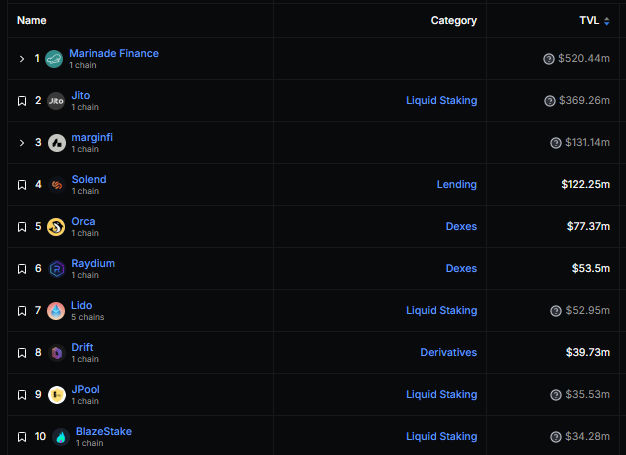
Source: https://defillama.com/chain/Solana?currency=SOL
Community
Breakpoint Attendees, Hackatons, and PlayGG
In 2023, the Breakpoint conference drew over 3,000 enthusiastic attendees, showcasing the continued vibrancy of the Solana community. While this marked a slight decrease from the 3,500+ participants in 2022, it remained a substantial leap from the inaugural 2021 event, which hosted 2,100 attendees. The sustained high attendance reaffirms the robustness of the Solana community.
Solana’s hackatons were also a success in 2023. Solana Grizzlython Online Hackathon, a global competition focused on bringing the next wave of high-impact projects into the Solana ecosystem saw over 10,000 participants submit 813 final projects to the judges ([source](https://solana.com/news/solana-grizzlython-winners)). Solana Hyperdrive Hackaton held in the fall of 2023 then saw more than 7,000 participants submit 907 final projects to the judges ([source](https://solana.com/news/solana-hyperdrive-hackathon-winners)).
During 2023, Solana community also hosted PlayGG - a gaming-focused conference that features some of the strongest games in the ecosystem including StarAtlas, Aurory, or Alchemy: Battle for Ankhos - for the first time.
OPOS Narrative
The overarching theme of this year's Breakpoint was the renaissance of Solana as a leading blockchain, revolving around OPOS - activities that are Only Possible On Solana. The event aimed to spotlight not only the projects thriving on Solana but also the network's exceptional speed and finality. During Breakpoint, rapid-fire showcases of OPOS activities were presented, featuring demonstrations such as Tweed's ticketing system, Orca's trading platform, Hivemapper's DePin mapping solution, or Sling's payment innovations.
Points Programs
A significant contributor to Solana's traction has been the introduction of points programs by the so-called DeFi 2.0 protocols - MarginFi, Cypher (pre-hack in August), Solend, Blaze, and Jito - throughout the second half of 2023.
Although not officially confirmed, points programs suggest the potential for airdrops for protocols lacking governance tokens and reward programs for those with existing tokens. For instance, Marinade entices users by offering 100 MNDE (Marinade’s governance token) for every 100 SOL staked.
The synergy of points programs, coupled with the compelling OPOS narrative and Solana's price changes, has significantly heightened awareness of the network. This influx of attention is not only attracting new participants but also generating a compounding wave of traction within the ecosystem.
Developers
Last important aspect is to assess developer traction on Solana and other chains. We primarily rely on three sources - NPM weekly library downloads (as a proxy to developer interest), the number of developers, and the number of commits as reported by Electric Capital’s State of Developer report.
NPM library downloads
In 2023, Solana maintained stability in weekly NPM library downloads, starting at 345k in November 2022 and ending at 333k in November 2023. Among other major blockchains, only Avalanche saw a year-over-year increase in weekly downloads. Ethereum, Near, and Polygon experienced declines ranging from -5% to -23% during the same period. Nonetheless, over a two-year span, Solana demonstrated the second strongest growth, growing 5.5x from November 2021, just behind Near's 6.4x increase. Note that in absolute terms, Solana consistently surpassed Near, with 5.5x+ more weekly downloads throughout. Since 2021, Solana significantly closed the gap with Ethereum, jumping from 9% of Ethereum's weekly downloads in 2021 to nearly 54% in 2023.

Developers and commits
Unfortunately, Solana paints a different picture when we consider total number of developers and commits. The chain witnessed the second-largest decline in total developers among leading L1 blockchains, plunging from 2,200 to just 946 developers (-57%). On the number of commits (which are based on public Github repos), Solana has been performing even worse, falling from 40.1k in October 2022 to 16.5k in October 2023 (-59%). The decline is not surprising, considering the repercussions of the FTX collapse and the impact it had on teams - facing financial hardships due to locked funds at FTX and subsequently also SVB, or relying on Alameda for funding. It's crucial to acknowledge though that the overall market, measured by the number of developers, contracted by 28%.
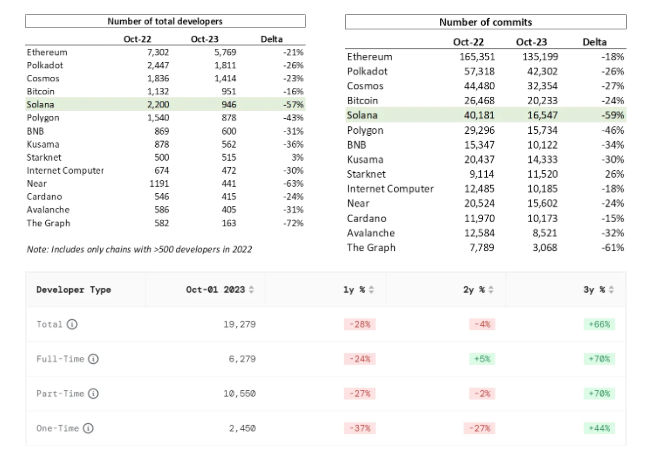
Source: https://www.developerreport.com/
Footnotes
(1) QUIC TPU - a new networking protocol built by Google. QUIC gives validators more control over the network traffic. It is designed for fast asynchronous communication like User Data Protocol (UDP), but with sessions and flow control like Transmission Control Protocol (TCP). All validators support QUIC since the latest Solana upgrade in November.
(2) QoS - Stake-weighted Quality of Service (QoS) means that small validators can’t flood other validators with traffic anymore. Since these upgrades were incorporated, uptime has been 100%.
(3) Local fee markets (partially implemented) - provide a way for users to pay an additional fee during transaction execution to prioritize transactions that modify the same account. For example, a simple token transfer would require a lower total priority fee compared to a NFT mint that expresses the same level of urgency.
(4) Markout is a metric used in high-frequency trading to gauge aggregate trade quality. It estimates the hypothetical realized PnL of a strategy if the trader exited every trade for the mid-market fair price at every fixed interval. While it is not equivalent to true PnL, it's a very close approximation of PnL from trade execution (vs. PnL from holding position/risk).